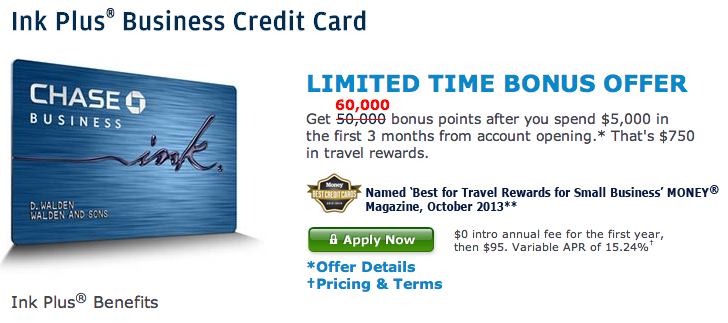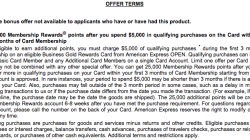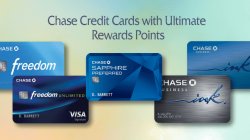This weekend is your last opportunity for the foreseeable future to apply for the Chase Ink Bold and Ink Plus business cards while the sign-up bonus has been temporarily increased to 60,000 Ultimate Rewards points. You’ll need to spend $5,000 in the first three months to earn the bonus points, and the first year’s annual fee is waived (normally $95 thereafter). I expect that the bonus will drop back to the regular 50,000 points after June 1, and we may not see 60,000 points again until this time next year.
I have an existing Ink Bold card that I opened for the blog when I first started out several years ago. No EIN or formal business structure is required. I simply used my Social Security Number and listed my business as a sole proprietorship. It’s been a good card for the 5X bonus on office supply purchases (read: gift cards) and telecom, and 2X bonus on hotel and gas purchases. Ever since Chase closed my Sapphire Preferred card for combining points with my mother’s and Megan’s accounts, I generally use this card when paying for hotel stays and my Premier Rewards Gold card for airline tickets.
Since I recently reorganized the business as an LLC, I applied for a new card. I could probably have done another Ink Bold, this time using the business’s EIN instead of my SSN. But the major difference between the two cards is that the Ink Bold is a charge card and must be paid off all at once. The Ink Plus is a credit card you can pay over time. I don’t like to carry a balance, but I do like to have the option.
Business applications are more intimidating, but the most important advice is to be honest. I don’t recommend making up a fictitious business; you’ll have trouble keeping the story straight. It may be acceptable to open a card for a business you have formed but isn’t yet generating revenue. The bank will expect you to justify your business model and expected revenue.
When I applied this morning I also included my personal financial information, which helps them know that they have someone else to go after should the business not be able to cover its bills. I didn’t worry about my personal address matching the business address. I also included my expected revenue for the business this year, using the average monthly income thus far. And I got the usual “decision pending” message when I submitted the application.
So I called the reconsideration line and asked, politely, “I just applied and was notified that my application is pending. Is there any information I can provide to help you with your decision?”
The representative put me on hold to review the application and then came back to review my details.
The business is three years old, correct? Yes. I made clear the LLC was formed this year but the business itself is three years old. He asked what I did, and I told him it’s a mix of freelance writing, advertising revenue from websites I run, and some consulting gigs on the side. We went year-by-year with the revenue and expenses for 2012, 2013, and my prediction for 2014 — showing growing profitability each year. I explained that I do have a day job and continue to run this business on the side. We talked about what I wanted to use the card for. (Hosting fees and travel expenses.)
And I was approved! Simple as that. The only complication was my credit line. My last Ink Bold card was approved with a $5,000 line, and I had to give up $10,000 in personal credit to get it. This time I was offered $5,000 with no sacrifice, and I was able to transfer some of my credit line from another personal card dollar-for-dollar.
Bottom line: Have answers for these questions. Don’t make stuff up. Be honest and explain how you run your business and what you need the card for. I think these are the questions every credit card application should have, but most of it is on the honor system. Heck, this is still on the honor system. But if you have nothing to hide, the agent will probably let you pass. You’ll end up just fine even though Chase is taking a closer look when it approves this kind of credit.
Update: A reader emailed me this FT post describing the problems that can arise if you have been doing extensive manufactured spending on your Chase cards in the past. You may not want to get a representative on the line for reconsideration if you’re worried about the questions they’ll ask. But my post isn’t necessarily meant to apply to the situation described on FT. I just meant to point out that many people applying for business cards will need to undergo more scrutiny, and this is one successful way to handle it.
I don’t have affiliate links for these cards, but I do have a list of these and other business card offers if you’re looking to separate personal and business expenses while earning some extra miles.






